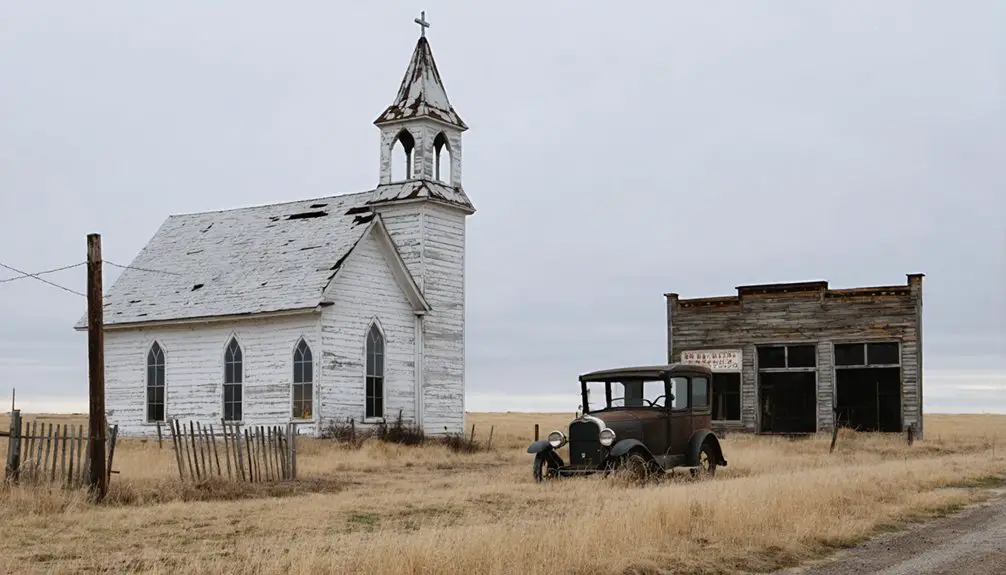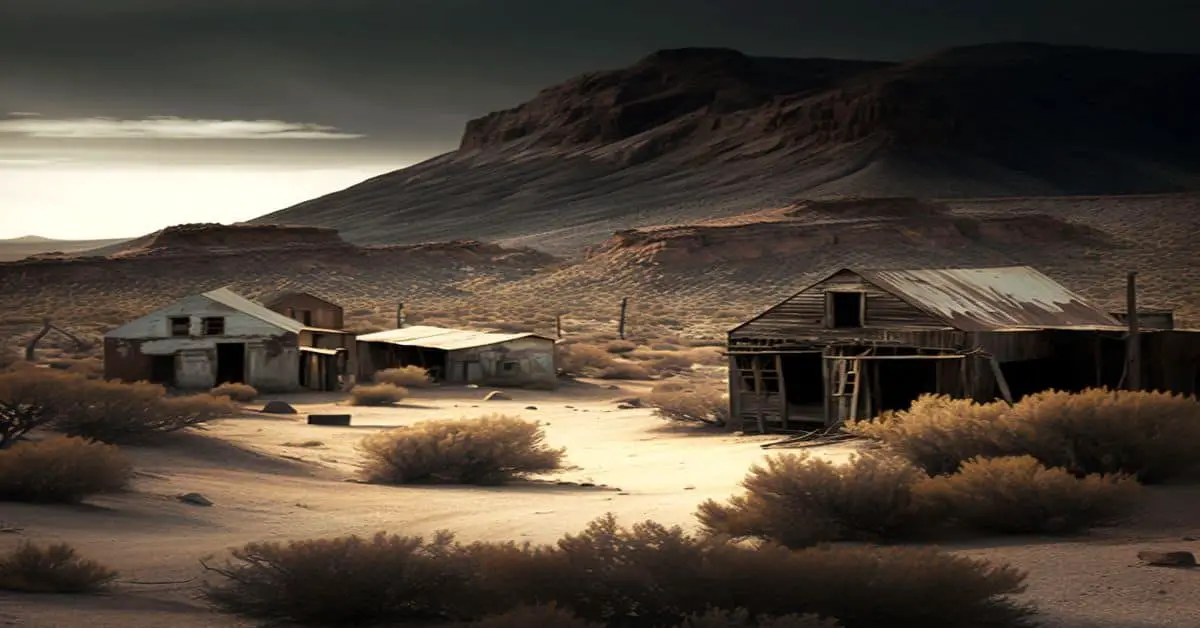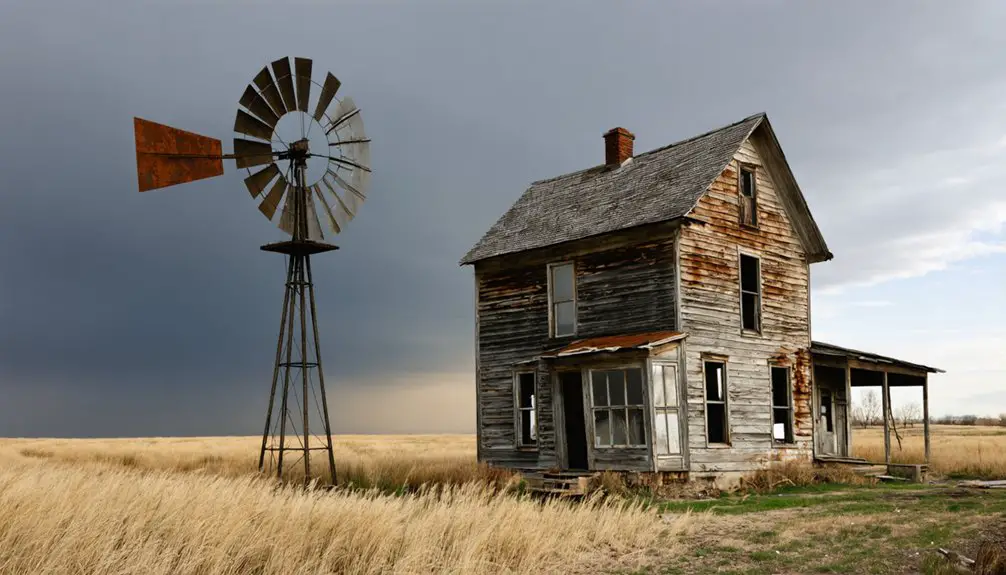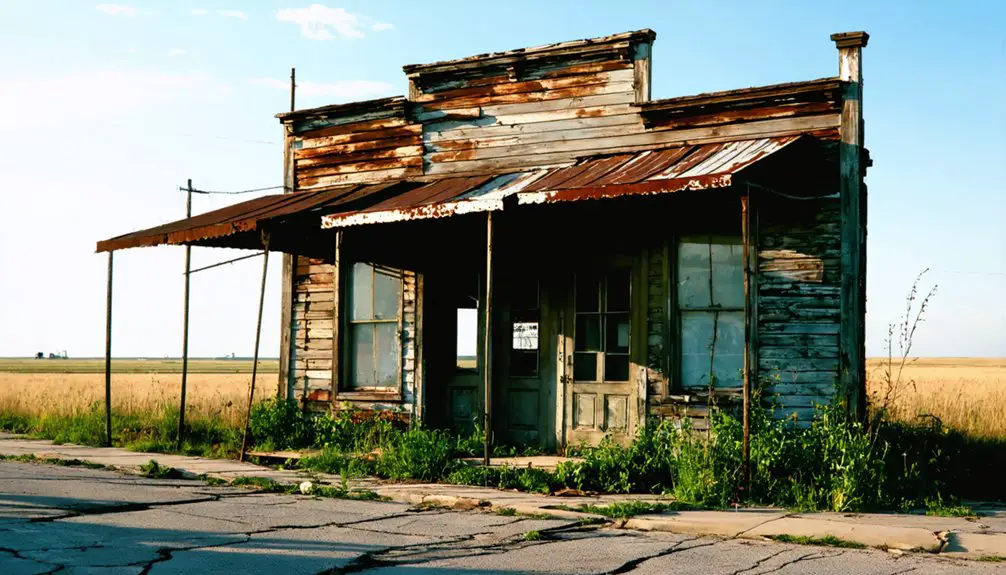You’ll discover Jacksonville, Nebraska was established in 1856 during westward expansion, with Edward H. Bischof and Charles F. Hunter planning its layout. The settlement grew to nearly 100 residents, thriving on agriculture and river trade. By the late 1870s, economic setbacks, including devalued town lots and institutional closures, led to its abandonment. Today, scattered remnants like foundation stones and cemetery headstones tell the story of this once-promising frontier town, with many untold stories still waiting in the Nebraska plains.
Key Takeaways
- Jacksonville, Nebraska was officially established in 1856 by Edward Bischof and Charles Hunter during the territory’s westward expansion period.
- The town reached its peak population of nearly 100 residents and thrived as an agricultural community with essential services.
- Economic decline began in the 1870s due to failed speculative investments and high-priced town lots losing value.
- The closure of the post office and withdrawal of Methodist conference support marked the town’s effective end.
- Today, only scattered structural remains, cemetery headstones, and foundation stones visible during low water periods mark Jacksonville’s location.
Origins and Early Settlement
As pioneers pushed westward during the mid-19th century, Jacksonville, Nebraska emerged as a promising settlement in Otoe County along the Missouri River. Landowners Edward H. Bischof and Charles F. Hunter played pivotal roles in shaping the town’s development, creating a well-planned layout with 75-foot-wide streets and 16-foot alleys.
The pioneer lifestyle attracted families and entrepreneurs seeking opportunities in agriculture and river trade. Much like Jacksonville, Florida’s rich 6,000-year history, the Nebraska settlement represented an important chapter in American frontier expansion. Similar to Florida’s Yukon settlement, the area featured cotton plantations that shaped its early agricultural economy.
On September 8, 1856, Jacksonville was officially platted, marking its formal establishment during Nebraska’s territorial period. Despite the settlement challenges common to frontier towns, including disease and limited resources, the community maintained cohesion through shared labor.
The town’s strategic location near the Missouri River offered potential for growth, though competition with neighboring settlements like Old Wyoming would later impact its destiny.
Geographic Setting and Natural Features
Jacksonville’s position in Nebraska’s river valley system placed it amid the region’s characteristic plains topography, with the settlement taking advantage of nearby waterways for transportation and resources.
You’ll find the town was situated on relatively flat to gently rolling terrain that proved suitable for early agricultural development and community building.
The natural setting provided essential resources including water access, timber along the riverbanks, and fertile soil for farming, though these same geographic features would later contribute to flooding challenges.
Like Yukon’s historic Mulberry Grove Plantation, the area’s rich soil supported various agricultural activities including cotton cultivation and livestock.
The region’s abundant pine forests supported a thriving naval stores industry that became crucial to the local economy.
River Valley Location
Situated within the North Platte River Valley, Jacksonville occupies a strategic position along one of Nebraska’s most significant watercourses. You’ll find this ghost town near where the North Platte River flows as a shallow, braided stream through Nebraska’s portion of the Great Plains. The river’s ecological significance stems from its rich riparian habitats and crucial role in the region’s watershed system.
The river supports a diverse ecosystem with its 30,900 square mile drainage basin. The valley’s depth becomes apparent when you consider nearby Scotts Bluff, towering 800 feet above the river. For river navigation and travel, this corridor proved invaluable, hosting major pioneer routes including the Oregon, California, and Mormon trails. The river’s elevation descends to 942 feet at its confluence with the Missouri River.
The surrounding Wildcat Hills and tributaries like the Loup River have shaped the valley’s distinctive character, creating a dynamic landscape of historical and natural importance.
Terrain and Land Features
The northeastern region of Florida houses the remnants of Jacksonville within Duval County, where you’ll find a coastal plain landscape characterized by flat terrain and gentle slopes.
The terrain features include elevations ranging from 10 to 25 feet above sea level, with scattered wetlands and marshy areas near the Ortega River. Much like potash production plants in Antioch, Nebraska, the landscape bears remnants of industrial activity. Old brick roads from Camp Johnston can still be found slowly sinking into the wooded areas.
The land composition consists primarily of alluvial soils from St. Johns River sediment deposits, creating a fertile foundation that supports diverse vegetation.
You’ll encounter sandy and loamy textures beneath your feet, perfect for sustaining mixed hardwoods, pines, and wetland species.
The area’s natural drainage patterns follow the low-lying topography, though much has changed due to urban development.
While many original features lie buried beneath Tillie K. Fowler Regional Park and modern infrastructure, you can still observe the land’s gradual reclamation by native flora.
Local Natural Resources
Rich mineral deposits and diverse ecological features mark the natural landscape around Jacksonville, Nebraska. You’ll find iron sulfide in the form of marcasite within the bluffs, while white clay deposits emerge along the Missouri River’s geological formations. These formations contain valuable limestone deposits that are essential for infrastructure development.
The area’s distinctive mineral resources include exposed layers revealed through riverbank erosion and the notable “Ionia Volcano” phenomenon. Steaming and smoking earth created what early explorers described as hot burning bluffs along the river.
The region’s wetland habitats encompass marshes, oxbows, and forested swamps that support vital wildlife populations. These areas work alongside mixed-grass prairies and scattered woodlands to create a complex ecosystem.
The Missouri River and its tributaries provide essential water resources while sustaining riparian forests. Together, these natural features contribute to soil fertility, carbon sequestration, and groundwater recharge, making the area historically valuable for settlement and agriculture.
Town Planning and Development
During Nebraska’s frontier expansion in the mid-19th century, Jacksonville’s town planners followed typical development patterns that emphasized organized grid layouts and dedicated public spaces.
The town’s infrastructure planning adhered to the 1858 Nebraska legislation regulating townsite development, with streets arranged in east-west and north-south directions for efficient navigation and property division.
- Streets and blocks were meticulously mapped out, creating a grid system that would’ve allowed for orderly growth and development.
- Land was designated for essential community facilities, including schools, a town hall, and public parks.
- Railroad right-of-ways were incorporated into the town layout, anticipating the critical role of rail transportation.
The ambitious town planning reflected Jacksonville’s aspirations for permanence and prosperity, though like many frontier settlements, these plans weren’t fully realized as economic and transportation patterns shifted over time.
Rise and Peak Years
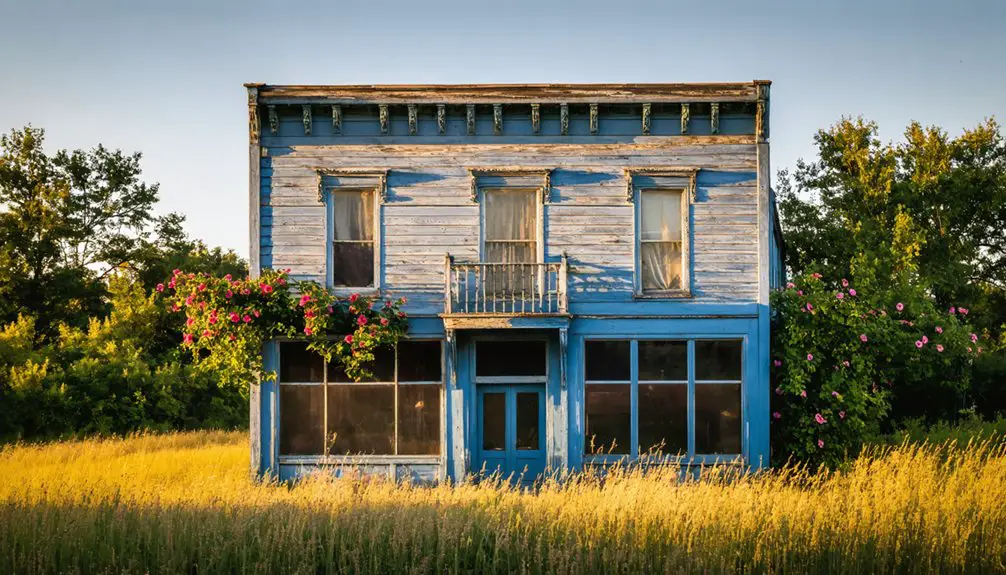
Following its official establishment in 1870, Jacksonville experienced rapid growth as settlers were drawn to the region’s agricultural prospects and new town amenities. The town’s population swelled to nearly 100 residents at its peak, driven by migration patterns typical of Nebraska’s frontier expansion.
You’d have found a bustling community with brick and frame buildings housing dry goods stores and essential services. The town’s community dynamics centered on agricultural rhythms, with social institutions like schools and churches fostering a strong sense of unity.
Local newspapers celebrated Jacksonville’s achievements while promoting its potential to newcomers. The town’s strategic location near transportation routes supported trade, though you’ll find it’s worth noting that this prosperity would later be challenged by competition from larger settlements like Omaha.
Economic Challenges and Decline
Jacksonville’s initial prosperity gave way to devastating economic setbacks in the late 1870s. The town’s economic failures became evident when speculative investments and high-priced town lots lost their value.
You’ll find that early investors rushed to sell their holdings at fire sale prices, while the Methodist conference’s withdrawal of support led to the closure of essential institutions. The final blow came with the post office’s shutdown, marking the community’s effective death.
- Empty storefronts with peeling paint stood as silent witnesses to broken dreams
- Abandoned rail lines cut through overgrown fields where commerce once thrived
- Weathered “For Sale” signs dotted the landscape of unmarketable properties
Despite attempts at community resilience, Jacksonville couldn’t overcome the perfect storm of vanishing capital support, loss of transportation infrastructure, and the exodus of its population.
Historical Significance
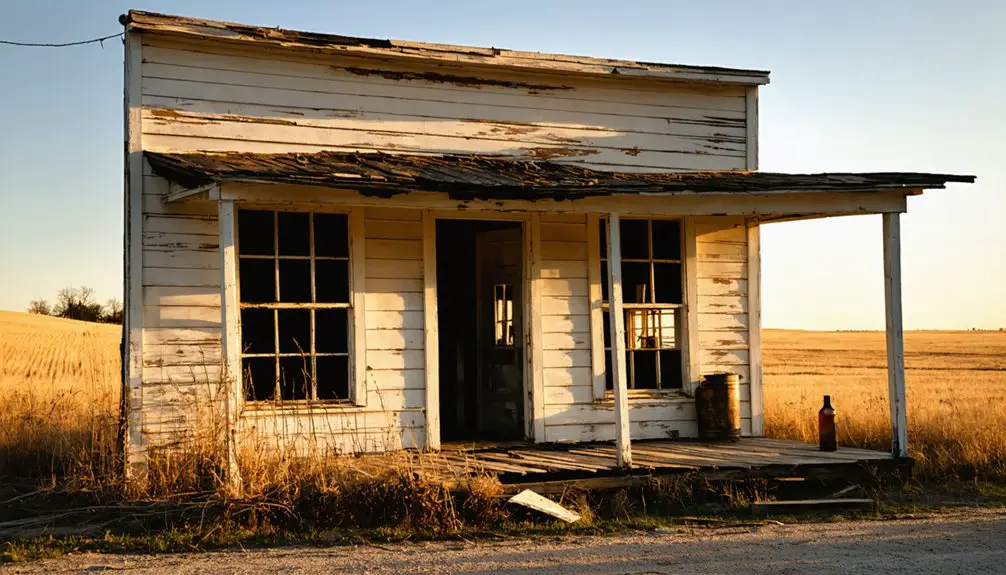
As one of Nebraska’s many frontier settlements established during territorial expansion, Jacksonville exemplified the ambitious town planning and development characteristic of mid-19th century America.
You’ll find its streets and plots were meticulously laid out, reflecting the era’s optimistic vision for transforming frontier lands into organized communities.
The town’s cultural narratives are woven into Nebraska’s broader pioneer identity, with early settlers contributing to local heritage through their struggles and achievements.
While Jacksonville didn’t achieve its intended prominence, it served as a meaningful hub for commerce and agriculture, supporting regional development during Nebraska’s territorial period.
Though falling short of grand aspirations, Jacksonville emerged as a vital trading center that strengthened Nebraska’s territorial growth.
The settlement’s archaeological remains and historical records now provide valuable insights into early Nebraskan life patterns, making it an important reference point for understanding the state’s pioneering era.
Present-Day Remnants
Today, scattered remnants of Jacksonville’s frontier past dot the Nebraska landscape, offering tangible connections to its territorial heritage.
You’ll find structural remains partially hidden beneath natural overgrowth, where vegetation gradually reclaims former thoroughfares and building foundations. During low water periods, you can spot weathered foundation stones that reveal the town’s original layout, while abandoned railroad lines converted to hiking trails trace the path of historical transportation routes.
- Stone foundations peek through tall grass, marking where homes and businesses once stood
- Former roadways, now narrowed by encroaching wilderness, wind through what was once a bustling downtown
- Cemetery headstones stand as silent sentinels, preserving the names and stories of Jacksonville’s early settlers
These physical remnants serve as windows into Nebraska’s territorial era, allowing you to walk among traces of frontier life.
Legacy and Cultural Impact
The enduring legacy of ghost towns like Jacksonville extends far beyond their physical remains, shaping Nebraska’s cultural identity through a rich tapestry of historical narratives and artistic expressions.
You’ll find its influence woven into regional folklore legends, cautionary tales, and artistic works that capture the rise and fall of frontier dreams.
The town’s story has become part of Nebraska’s broader cultural nostalgia, serving as a powerful reminder of 19th-century settlement ambitions and their often-harsh realities.
Today, you can explore Jacksonville’s impact through historical society exhibits, educational programs, and artistic interpretations that keep its memory alive.
The ghost town continues to educate new generations about the challenges of frontier life while inspiring photographers, writers, and artists who document its haunting remnants as symbols of American westward expansion.
Frequently Asked Questions
Were There Any Notable Crimes or Lawlessness Reported in Jacksonville?
You won’t find many ghost stories or crime reports to tweet about – historical records don’t show notable lawlessness in Jacksonville beyond regional Native American conflicts during the 1860s settlement period.
What Native American Tribes Originally Inhabited the Jacksonville Area?
You’ll find that Native tribes like the Pawnee and Otoe originally claimed this cultural heritage area, with the Pawnee establishing agricultural settlements along waterways and the Otoe arriving during the 18th century.
Did Jacksonville Have a Newspaper During Its Brief Existence?
You won’t find any historical publications from Jacksonville’s fleeting existence. While Nebraska Territory had several frontier papers, there’s no evidence that Jacksonville ever established its own newspaper during its short-lived period.
What Happened to the Residents After They Abandoned Jacksonville?
You’ll find post abandonment migration led residents to larger Nebraska towns like Nebraska City and Brownville, while others pushed westward seeking new opportunities. Their legacy lives on through descendants in established communities.
Were There Any Documented Epidemics or Natural Disasters in Jacksonville?
Precise proof proves problematic since you’ll find no documented epidemic outbreaks or natural disasters specifically linked to Jacksonville. You’re looking at typical frontier hardships rather than catastrophic events that caused its decline.
References
- http://www.gribblenation.org/2018/02/ghost-town-tuesday-yukon-fl-abandoned.html
- https://www.thejaxsonmag.com/article/ghost-town-yukon-florida/
- https://history.nebraska.gov/wp-content/uploads/2017/12/doc_publications_NH1937GhostTowns.pdf
- https://www.americanheritage.com/ghost-town-river
- https://www.youtube.com/watch?v=redtU6GT-BY
- https://usghostadventures.com/jacksonville-ghost-tour/
- https://usghostadventures.com/omaha-ghost-tour/
- https://nebraskarules.tripod.com/id3.html
- https://www.thejaxsonmag.com/article/jacksonvilles-ghost-town-yukon/
- https://www.thejaxsonmag.com/article/jacksonville-ghost-towns-greenland/
